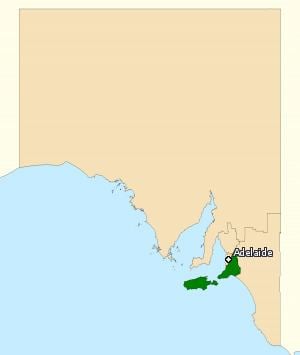Created 1984 Electors 103,967 (2016) Founded 1984 Elector 103,967 | Demographic Rural | |
 | ||
Area 9,315 km (3,596.5 sq mi) | ||
The Division of Mayo is an Australian electoral division located to the east, south, south-east and south-west of Adelaide, South Australia. Established in the South Australian redistribution of 3 September 1984, the division is named after Helen Mayo, a social activist and the first woman elected to an Australian University Council. The 9,315 km² seat covers an area from Springton in the North to Goolwa in the South. It takes in the Adelaide Hills, Fleurieu Peninsula and Kangaroo Island, including the towns of Bridgewater, Crafers, Echunga, Gumeracha, Hahndorf, Kingscote, Langhorne Creek, Lobethal, Macclesfield, Mount Barker, Myponga, Oakbank, Stirling, Strathalbyn, Victor Harbor, Woodside, Yankalilla, and part of Birdwood.
Contents
Electorate history
At its creation, Mayo was a rural based electorate that stretched from the seaside town of Victor Harbor to the Adelaide Hills. Mayo was created as a Liberal seat on a notionally safe 12.3 per cent two-party margin. Liberal Alexander Downer, fifth and last of the Downer family dynasty, won Mayo for the Liberals at the inaugural 1984 election and would hold the seat for 24 years.
At the 1990 election, the Australian Democrats, who traditionally polled better in the area covered by Mayo than anywhere else in Australia, first revealed themselves as a real contender in that seat, polling a primary vote of 21.3 per cent from an increase of 11.7 per cent, coming third by just 2 per cent of the primary vote less than Labor. Then-Democrats leader Janine Haines chose to contest the neighbouring Division of Kingston at the 1990 election, obtaining a 26.4 per cent primary vote, but came third well behind the Liberals, with sitting Labor member Gordon Bilney retaining the seat. It was speculated at the time that if the high-profile Haines had contested Mayo instead, she may have been able to defeat Downer—presumably by gaining the additional 2 percent the Democrats needed to overtake Labor for second place, and defeat Downer on Labor preferences.
A redistribution following the 1990 election shifted Mayo to an exclusively Hills based seat, reducing the Liberal hold by 2 per cent to a notionally fairly safe 9.6 two-party margin, but was won at forthcoming elections on safe margins. At the 1998 election however, high-profile Democrats candidate John Schumann polled a primary vote of 22.4 per cent. He ended up with a two-candidate vote of 48.3 per cent, just 1.7 per cent (3,000 votes) short of taking the seat, transforming Mayo in to a marginal seat for the first time. However, on "traditional" two-party terms, it only edged from fairly safe to safe Liberal.
Another redistribution following the 1998 election made Mayo a notionally safe two-party Liberal seat with an extra 1 per cent added to the two-party margin. Downer would be comfortably returned in Mayo until his political retirement. At the 2001 election, Labor returned to second place after preferences. At the 2004 election, independent candidate Brian Deegan polled a 15 per cent primary vote, overtook Labor after preferences, and polled a 38.2 per cent two-candidate vote. Downer recorded his and Mayo's lowest winning two-party result at the 2007 election with a much reduced 7.1 per cent two-party margin after a 6.5 per cent two-party swing.
Downer retired from politics triggering a 2008 Mayo by-election. Labor opted not to run a candidate. Jamie Briggs retained the seat for the Liberals on a 3 per cent two-candidate margin against the Greens, once again transforming Mayo in to a marginal seat. At the 2010 election, the seat was won by the Liberals on a fairly safe two-party margin for only the second time, before once again becoming a safe Liberal seat at the 2013 election.
2016 election and Xenophon
South Australian Senator Nick Xenophon confirmed in December 2014 that by mid-2015 the Nick Xenophon Team (NXT) would announce candidates in the South Australian Liberal seats of Hindmarsh, Sturt and Mayo, along with seats in all states and territories at the 2016 election, with Xenophon citing the government's ambiguity on the Collins-class submarine replacement project as motivation. ABC psephologist Antony Green's 2016 federal election guide for South Australia stated NXT had a "strong chance of winning lower house seats and three or four Senate seats". NXT's candidate was former Briggs staffer Rebekha Sharkie, who is associated with a wide range of organisations in the Adelaide Hills.
Multiple seat-level opinion polls in Mayo found NXT surprisingly leading the Liberals on the two-candidate vote during the 2016 election campaign. Seat-level opinion polls in the other two rural Liberal South Australian seats, both Grey and Barker, also found NXT leading the Liberals.
Sharkie was successful in defeating Liberal incumbent Briggs in Mayo at the 2016 election with a 55 percent two-candidate vote to the Liberals' 45 percent two-candidate vote, a reduction of 17.2 percent. This marked the first time this seat has been out of Liberal hands since its creation. Additionally, Mayo became a marginal two-party seat for the first time with the Liberal two-party-preferred vote reduced to 55.4 percent, a reduction of 7.2 percent.
